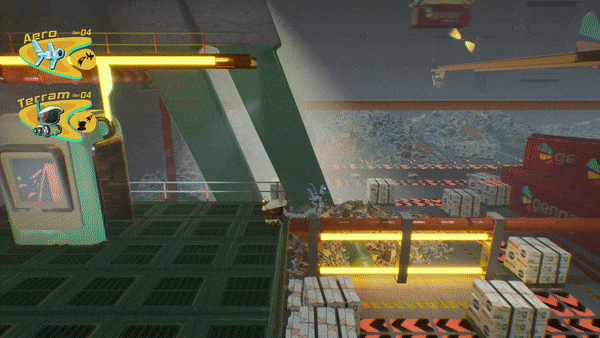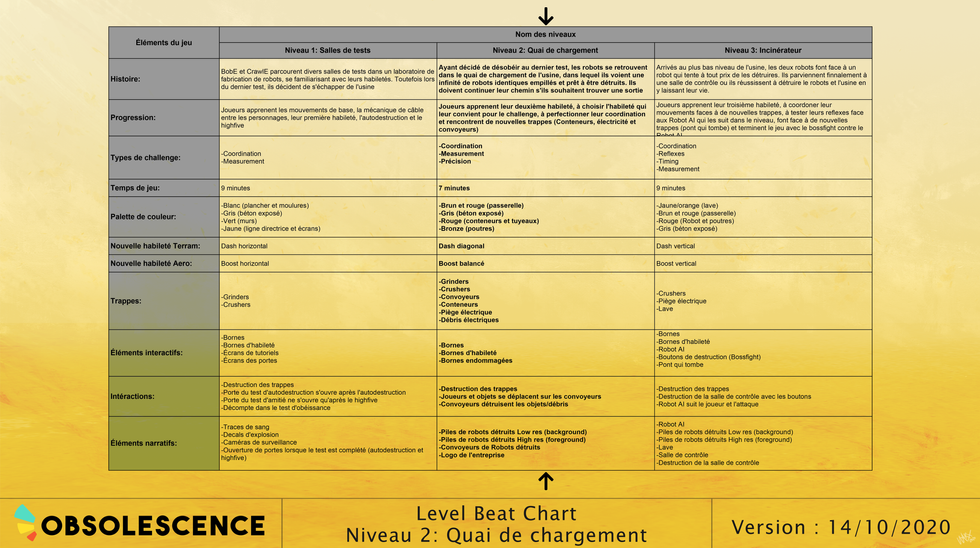

Level 02 Loading docks
As a level designer on the Obsolescence project, my role on the second level was to create:
- Paper layouts to establish the player's course, and the progression and teaching of mechanics
- Blockings in the game engine to test the readability of the environment and the clarity of the objectives
- Blueprint prototyping of the mechanics and scripted events of the levels
- The level art of the levels thanks to the assets created by our 3D artists
Through these steps, I took care of organizing several playtests in order to iterate on the levels with the player's feedback.
Level design
The second level is a gigantic warehouse / loading dock that players must pass through in order to escape their fate. You can see an infinite number of defective robots, similar to the players, being shredded and piled up like garbage.
The level design objectives of the level were to present to the players:
1) The diagonal dash and the conveyors
2) A new trap: containers
3) The vertical booster and the Aero recharge
4) A new trap: electric hatches
5) Electrical debris and defective terminal
1) Diagonal dash and conveyors

The second skill obtained by Terram is a diagonal dash. In order to teach the metrics of this skill the first obstacle is a series of boxes that can be cleared with the minimum force of the skill.
These boxes move on a conveyor and allow to integrate the background of the level into the gameplay. This skill gives Terram a bit more control in the air and makes it easier to pass through the traps in this level.
2) New trap: the containers


Containers are a new type of trap that arrives at high speed from the background. This type of trap allowed to:
- Integrate the background into the gameplay of the level and thus differentiate it from the first level
- Fix a problem present during playtests, the fact that players hovered over part of the level, avoiding most of the traps
3) Vertical booster and Aero skill recharge


The second skill of Aero is a vertical booster allowing to overcome the obstacles of the second level with more ease. To differentiate it from the first booster, it's effect is much faster and last less time. To teach its use, a first obstacle can only be crossed using this skill.
During the playtests I observed that the players, with this skill, could easily avoid the majority of obstacles by flying over the level. At this point, the skill was recharging at all times and quite quickly. To solve this problem we changed two things :
- Aero skill only recharges when Terram hits the ground
- Aero skill recharges much faster to not frustrate players
4) New trap: Electric trap


Electric traps are first seen during the first level, in order to teach their danger in a safe way and then encountered during the second level. During the playtests I observed that it was quite difficult to distinguish when the trap was harmless. To solve this problem I :
- Doubled the size of the effect of electricity when it is dangerous
- Halved the size of the FX of electricity when harmless
5) Electric debris and defective terminal


Players having already learned about the danger of electric traps, a mobile version of the same trap was added to create a more difficult challenge of coordination and precision at the end of to the level.
At this point, players encounter one last terminal which fails and explode (not damaging the players). We placed it in order to emphasize that the warehouse seems to be slowly falling into disrepair. In order not to frustrate the player by removing a respawn terminal, another terminal is present at the start of the next level, with no obstacles in between.
Level art
The second level of the game consists of a gigantic loading dock in which a panoply of conveyors seem to move an infinite number of materials towards shredders. Among other things, we can see defective robots, similar to those controlled by the players, being shredded in the background. This area aims to show a certain decadence through the constant waste of material which keeps piling up and being destroyed. This level, by its very large size, was also a great opportunity to mix the background of the environment with the mechanics of the game. For example, we can see the boxes arriving from the background on the conveyors before the player has to avoid them, and containers arriving from the background on rails, in order to give the player a chance to dodge them. For the creation of this level, the proxy tool of the Unreal 4 game engine was particularly useful in order to optimize the mountains of debris present everywhere in the level.



















